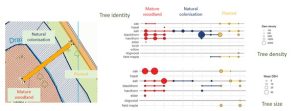Summary
Overview
Interdisciplinary fieldwork aims to establish a robust methodology to assess the efficacy of ‘natural colonisation’ as an approach to establish new woodland and its impacts on biodiversity and above and below ground carbon.
This project is part of the Nature for Climate Fund.
Methodology
Areas of natural colonisation established within agriculturally dominated landscapes and initiated with the previous 10-20 years were selected. Each of the sites contained three distinct areas of woodland:
- an area of mature existing woodland (as a potential source woodland)
- an adjacent area of natural colonisation
- an area of supplementary tree planting (planting adjacent to natural colonisation) or control planting (planting nearby, but not adjacent to the natural colonisation).
At least three rectangular transects were used to capture spatial variation across the sites. All sampling took place within these transects: the whole transect was divided into sub-transects for terrestrial laser scanning and photogrammetry flights (results to be presented in the next phase of the project) and plots positioned along the transect were used to manually sample tree size and species, as well as other vegetation cover. Soil samples were taken across the same transects.
Research Objectives
Key questions being evidenced are:
- Which tree species have colonised and established via natural colonisation?
- What is the density and height of the colonising trees at different spatial scales across the sites?
- What is the corresponding impact of natural colonisation on above ground biomass and below ground carbon?
- Is there an impact of adjacent or nearby tree planting, established at a similar time to the natural colonisation, on the colonisation and establishment processes?
Findings and Recommendations
Preliminary year 1 findings (2021/22)

Trees appear to be colonising the studied sites in three main ways, related to tree dispersal mechanisms, potentially ground preparation and browsing pressure:
- Steadily creeping out from adjacent mature woodland as hypothesised e.g. oak and beech, but especially evident at one site where the site was seeded to grass from arable and there is very low herbivore pressure.
- Wind dispersed species dominating sites e.g. willow and ash. Willow is particularly dominant in areas with low competition from other species such as grass.
- Vector dispersed species e.g. blackthorn appearing not only adjacent to mature woodland but also influenced by nearby tree planting.
However, this first year pilot study has demonstrated the high degree of variability within and between the sites which need to be investigated further to be able to provide generalisable evidence.
Latest Update
Work in year 2 (2022/23) will expand the sample of sites to include a wider range of ages and starting land use.
Funding & Partners
- This project has been funded through the Government's ‘ Nature for Climate Fund’
-
 DEFRA
DEFRA -
Collaborating Partners
-
 Forestry Commission
Forestry Commission
